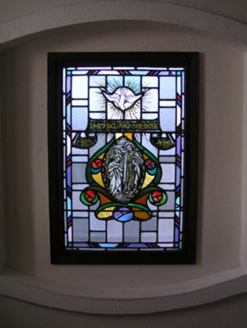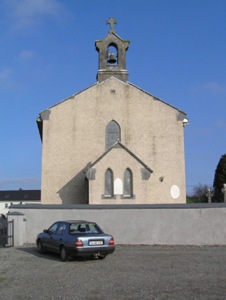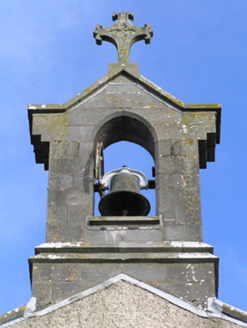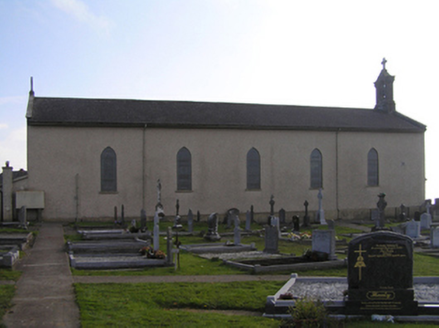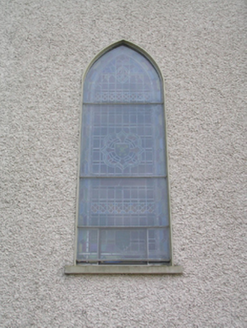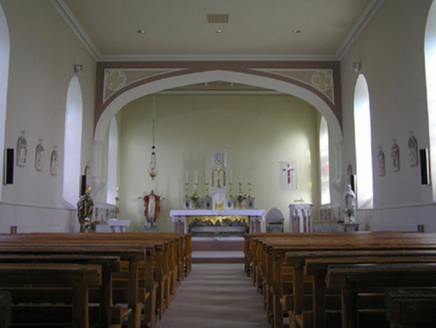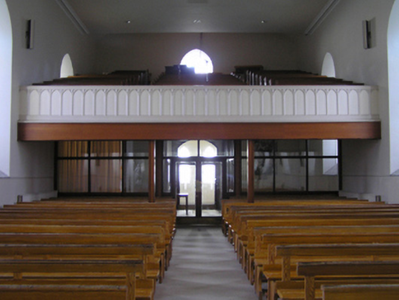Survey Data
Reg No
12401004
Rating
Regional
Categories of Special Interest
Architectural, Artistic, Historical, Social
Previous Name
Saint Coleman's Catholic Church
Original Use
Church/chapel
In Use As
Church/chapel
Date
1830 - 1835
Coordinates
248113, 167897
Date Recorded
03/11/2004
Date Updated
--/--/--
Description
Detached five-bay double-height single-cell Catholic church, built 1832, on a rectangular plan; single-bay single-storey gabled projecting porch to entrance (west) front. "Improved", 1905, producing present composition. Renovated with sanctuary reordered. Pitched slate roof with clay ridge tiles, cut-limestone coping to gables on cut-limestone ogee kneelers including cut-limestone coping to gable to entrance (west) front on cut-limestone ogee kneelers with Cross finial-topped drag edged tooled limestone ashlar gabled bellcote to apex framing embossed cast-iron bell, and cast-iron rainwater goods on timber eaves boards retaining cast-iron downpipes; pitched (gabled) slate roof (porch) with trefoil-perforated crested terracotta ridge tiles, cut-limestone coping to gable on cut-limestone ogee kneelers, and cast-iron rainwater goods on cut-limestone "Cavetto" consoles retaining cast-iron downpipes. Roughcast walls on rendered plinth. Lancet window openings with concrete sills, and concealed dressings framing storm glazing over fixed-pane fittings having leaded stained glass margins centred on leaded stained glass pierced quatrefoils. Lancet window opening to entrance (west) front with concrete sill, and concealed dressings framing storm glazing over fixed-pane fitting having leaded stained glass margins centred on leaded stained glass pierced quatrefoil. Paired lancet window openings (porch) with cut-limestone chamfered flush sills, and concealed dressings having chamfered reveals framing storm glazing over fixed-pane fittings having stained glass margins centred on lattice glazing bars. Square-headed opposing door openings ("cheeks") with concealed dressings framing timber boarded double doors. Interior including vestibule (west); segmental-headed door opening into nave with replacement glazed timber double doors having overlight; full-height interior with timber panelled choir gallery (west) on pillars, central aisle between replacement timber pews, grouped stations between stained glass memorial windows, moulded plasterwork cornice to ceiling, and quatrefoil-detailed Tudor-headed chancel arch framing carpeted stepped dais to sanctuary (east) reordered with mosaic tiled altar. Set in landscaped grounds with limestone ashlar piers to perimeter having shallow pyramidal capping supporting replacement mild steel double gates.
Appraisal
A church representing an integral component of the ecclesiastical heritage of County Kilkenny with the architectural value of the composition, one showing the hallmarks of a period of construction coinciding with the Roman Catholic Relief Act, 1829, suggested by such attributes as the rectilinear "barn" plan form, aligned along a liturgically-correct axis; the slender profile of the openings underpinning a "medieval" Gothic theme; and the bellcote embellishing the roofline as a picturesque eye-catcher in the landscape: meanwhile, aspects of the composition illustrate the later "improvement" of the church to designs by William Henry Byrne and Son (formed 1902) of Suffolk Street, Dublin (Irish Builder 23rd September 1905, 660). Having been well maintained, the form and massing survive intact together with quantities of the original fabric, both to the exterior and to the interior reordered in accordance with the liturgical reforms sanctioned by the Second Ecumenical Council of the Vatican (1962-5) where stained glass; sleek plasterwork refinements; and a much modified altar, all highlight the artistic potential of a church making a pleasing visual statement in a sylvan street scene. NOTE: An oval plaque commemorates Reverend Patrick Byrne (c.1798-1869) 'who was pastor of Skirk for six years and of Conahy for 20 years'.
